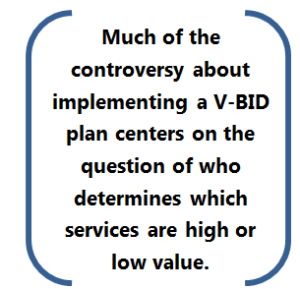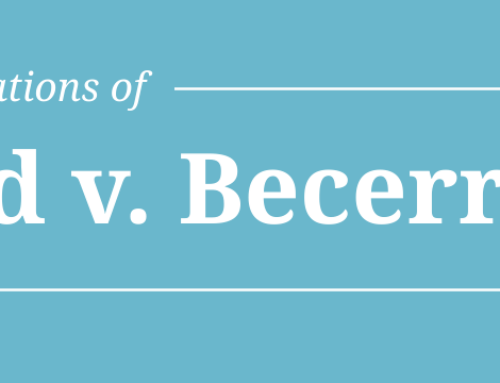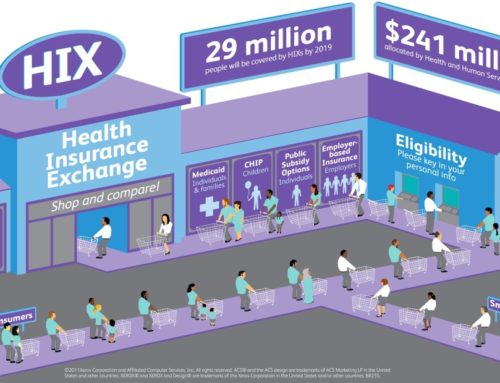Originally Produced: September 2012 Updated: June 2016
Communicating with Consumers about Value-Based Insurance Design
Value-Based Insurance Design (V-BID) is one of the most innovative and widely implemented approaches to enhance clinical outcomes and control the cost of health care. V-BID programs lower financial barriers to specific preventive services, diagnostic tests, treatments, and providers demonstrated to be of high value across the entire continuum of clinical care. Studies show that when barriers to high-value care are reduced, patient compliance with recommended treatments increasesii and potential cost savings result.iii V-BID programs may also impose higher out-of-pocket cost-sharing for consumers to discourage the use of services of marginal or unproven value.iv Restructuring health insurance plans to provide patient incentives for evidence-based care can help refocus the health care system on quality outcomes rather than volume.
Public and private employers have been implementing V-BID programs for more than a decade, and the use of V-BID is increasing. According to the 2010 Mercer National Survey of Employer-Sponsored Health Plans, 81 percent of large employers plan to offer V-BID in the near future.v Yet, implementers have faced challenges in effectively communicating with employees about the goals and values of the plans. Different obstacles may arise for V-BID programs designed for all employees such as age-appropriate screenings, than for programs targeted to particular patient populations such as individuals who smoke or have been diagnosed with a specific condition such as diabetes.vi Research gauging public opinion about V-BID is nascent, though recently completed focus groups provide insights into how consumers perceive V-BID programs, and how V-BID programs can be most effectively communicated.i,vii,viii
Reactions to V-BID
A 2012 V-BID Center qualitative study of individuals with employer-sponsored health insurance found concern regarding health care quality and affordability, yet focus group participants expressed guarded optimism about V-BID’s potential to make care more effective.i There was broad support for “carrot” V-BID plans (making valuable care more affordable) especially when these designs were perceived as saving money and lowering insurance premiums for all beneficiaries.i This finding aligns with results from a 2012 Center for Healthcare Decisions report that strongly supported keeping cost-sharing limited for those with chronic disease.vii
Participants in the V-BID Center study also defended the values of individual responsibility and fairness when it comes to health, yet opinions were mixed regarding the use of clinical nuance in plan design. Some preferred that health plans offer incentives to a broader group of people (rather than singling out specific conditions) while others favored targeting support for those that demonstrate the greatest health needs.
Much of the controversy about implementing a V-BID plan centers on the question of who determines which services are high or low value. There was no clear consensus in the focus groups about making low-value care less accessible; some objected to “stick” implementations (raising costs for dangerous or low-value care) because they want doctors to be the arbiters of these decisions. Others advocated for increased cost-sharing when evidence-based guidelines advise against the use of a particular service.
A plurality of people in the focus groups supported raising patient co-payments for unnecessary MRIs and a majority supported discontinuing coverage for a hypothetical experimental cancer drug that lost FDA approval.i In general, support was particularly high for V-BID “stick” interventions that align with FDA findings around approved uses for drugs. Several participants also expressed interest in an exceptions process, allowing second opinions, provisions for “grandfathering” patients, or other approaches to make sticks less absolute.
Keys to Communicating About V-BID
How employers and other V-BID implementers communicate about V-BID impacts the program’s level of public acceptance. A second focus group study completed in 2012 addressed the question of how employers can best present V-BID to participating employees.viii Among other recommendations, this study found that employers should:
- Focus communications efforts on actionable ideas to improve health and control costs. For example, provide sample questions for consumers to ask their doctors. When possible, draw on real in-house success stories to make communications efforts more impactful.
- When using health questionnaires and assessments, communicate screenings as the first phase in a journey to be healthier—describe a comprehensive health enhancement program.
- Consistently communicate about the company’s benefit design and coverage options for prescription medications. Provide concrete examples.
- Use surveys or similar tools to gather employee views. Draw on these insights to develop effective coaching programs and guide ongoing communication efforts.
- When encouraging employees to seek care from certain providers, offer detailed information about the organizations that are rating providers and the criteria used. Show employees how the new designs differ from current offerings (i.e., in- and out-of-network costs).
Effective communication with consumers around V-BID is essential for promoting engagement, optimizing participation, and avoiding unexpected negative consumer experiences. However, many employees are unfamiliar with basic cost-sharing terminologyviii and the clinical nuances of a V-BID program may not be immediately intuitive. Therefore, a deliberate, carefully-executed communications strategy can help consumers and employers obtain maximum benefit from V-BID. Better health and lower costs await.
For More Information
References:
iThe complete study with detailed recommendations can be found online: Probing The Public’s Views On V-BID. Center for Value-Based Insurance Design, Center for Healthcare Decisions, Integrated Health Partners. June 2012. Accessed at: http://vbidcenter.org/wp-content/uploads/2014/08/VBID-ProbingthePublicsViewonVBID-Jun12.pdf
iiChernew ME, Shah MR, Wegh A, Rosenberg SN, Juster IA, Rosen AB, Sokol MC, Yu-Isenberg K, Fendrick AM. Impact Of Decreasing Copayments On Medication Adherence Within A Disease Management Environment. Health Affairs, 2008: 27; 103-112. http://content.healthaffairs.org/content/27/1/103.long
iiiChernew ME, Juster IA, Shah M, Wegh A, Rosenberg S, Rosen AB, Sokol MC, Yu-Isenberg K, and Fendrick AM. Evidence That Value-Based Insurance Can Be Effective. Health Affairs, 2010: 29; 1-7. http://content.healthaffairs.org/content/29/3/530.full
ivFendrick AM, Smith DG, Chernew ME (2010). Applying Value-Based Insurance Design To Low-Value Health Services. Health Affairs, 2010: 29; 2017-2021. http://content.healthaffairs.org/content/29/11/2017.full
vChoudhry NK, Rosenthal MB, Milstein A. Assessing The Evidence For Value-Based Insurance Design. Health Affairs, 2010: 29; 1988-1994. http://content.healthaffairs.org/content/29/11/1988.long
viPurchasers may also wish to consult the U.S. Preventive Services Task Force website for information on evidence-based care at http://www.ahrq.gov/clinic/uspstfix.htm
viiSharing In The Cost Of Care: Perspectives From Potential Health Plan Users Of The California Health Benefit Exchange. Center for Healthcare Decisions. June 2012. Accessed at: http://chcd.org/docs/hbex_report_6.15.12.pdf







